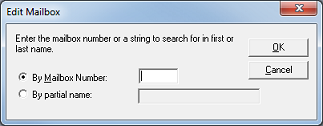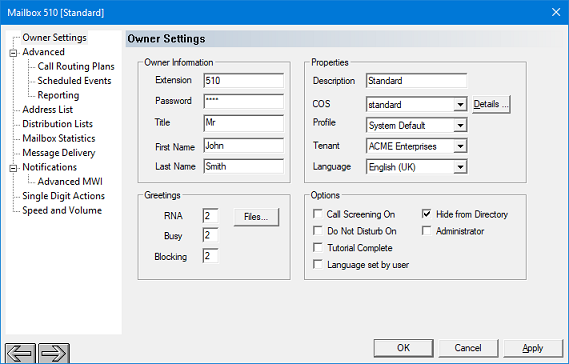Table of Contents
Edit (single)
There are three ways to open a mailbox for editing:
- Double-click on it in the mailbox list
- Right-click on it in the mailbox list and select Open from the context menu
- Use the Mailbox | Edit option in the main menu
Double-clicking on the mailbox in the list is the easiest, and therefore preferred, method. However, if you have hundreds of mailboxes in the list and are having trouble finding it, you can use the third method listed above to invoke the Edit Mailbox dialog which allows you to specify the mailbox to edit either by number or by the mailbox subscriber's name.

Enter the mailbox number if you know it or, if you don't, you can try to find a match by part or all of the subscriber's first or last name. If you choose the latter option, be sure to enter enough letters to uniquely identify a single mailbox, as it will select the first match it finds which may not be the mailbox you want.
Click OK. If the system finds the specified mailbox, it will open it in the Mailbox Editor for you to edit, otherwise you will get an error message.
Because mailbox type is so intrinsic, it cannot be changed after the mailbox is created. If you want to change the type of a mailbox, you must delete it first and recreate it with the desired type.
Mailbox Editor
The Mailbox Editor is used to modify the properties of an individual mailbox, allowing it to be customized to suit a particular need or subscriber.
There are four main parts to the dialog: the title bar, the category list, the property page display and the command buttons. The screenshot below is a typical example of the Mailbox Editor being used to edit a standard mailbox.

Title bar
The dialog's title bar always displays the word 'Mailbox' followed by the mailbox number and then the mailbox type in square brackets.
Category list
All mailbox properties are grouped into various categories (and may be further sub-grouped within those categories). These categories are listed in a tree control displayed on the left side of the dialog, below the title bar. As shown in the example above, a plus (+) or minus (-) sign may appear next to a category to indicate that it has one or more subcategories. You can click on the plus sign to expand the list (i.e., to show the subcategories) or click on the minus sign to collapse the list (i.e., hide the subcategories).
The following categories may appear in the list. Not all categories are listed for all mailbox types, and some are only valid for a specific mailbox type.
| Category | Description |
|---|---|
| Owner Settings | Displays the main mailbox settings, such as extension number, password and name. The exact configuration of this page depends on the mailbox type. |
| Administrator System Events | Allows you to enable the system to send you messages when the system's disk space gets too low. This option is only displayed if the Administrator option is enabled on the Owner Settings page. |
| Advanced | There are no settings on this page. Select one of the subcategories:
|
| Address List | Allows you to add, edit and delete addresses (email, phone, pager, MWI, etc.). |
| Distribution List | Allows you to manage the distribution list associated with a distribution mailbox. |
| Distribution Lists | Allows you to manage up to 9 personal distribution lists for a standard mailbox. |
| Emergency Alert | Provides options to have an email or voice message delivered whenever someone dials a configured emergency number. This feature is only available if the PBX is an Avaya IP Office with DevLink enabled. |
| Mailbox Statistics | Displays mailbox usage statistics. |
| Message Delivery | Allows you to assign message delivery templates to the mailbox. |
| Notifications | Allows you to assign notification templates to the mailbox. The subcategory Advanced MWI allows you to assign a specific line to perform MWI notifications for this mailbox. |
| QA Script | Allows you to assign a global QA script or edit a custom script as well as configure the associated settings. Only displayed for QA mailboxes. |
| Single Digit Actions | Allows you to review the assigned single digit action (SDA) template or to create and edit a custom template. |
| Speed and Volume | Allows you to adjust the default speed and volume for both messages and system prompts. |
Property Pages
Each category (and subcategory) has an associated property page which is displayed in the main portion of the dialog to the right of the category list. As you change the selection from one category to another in the tree control, the property page displayed on the right will also change to display the properties that are contained in the currently selected category.
Command Buttons
There are six command buttons placed along the bottom of the dialog: two arrow buttons below the category list on the left, and three other buttons below the property page on the right.
Arrow buttons
You can use the left and right arrow buttons to change which mailbox you are editing without exiting the Mailbox Editor. The left arrow moves to previous mailbox in the list and the right arrow moves to the next mailbox. The order of mailboxes is always determined by how they are currently ordered in the list in the main window.
If you have edited the current mailbox in any way, and have not yet applied those changes, then you will be prompted whether to save the changes before the new mailbox data can be loaded into the dialog. Even if you have not made any changes, there may be a brief pause as the current data is flushed and the next (or previous) mailbox's data is loaded.
Other buttons
To save you changes and continue editing the mailbox, click Apply.
To save your changes and close the editor, click OK.
To discard any changes, click Cancel.